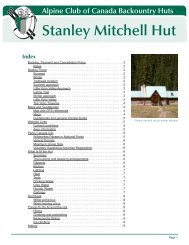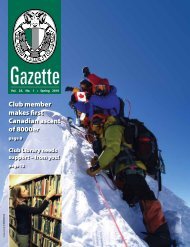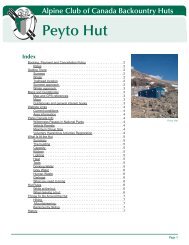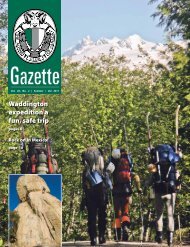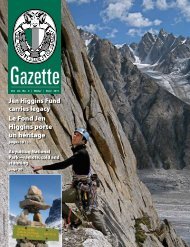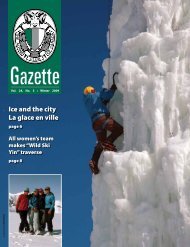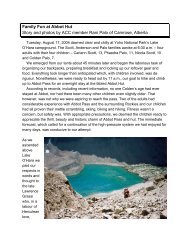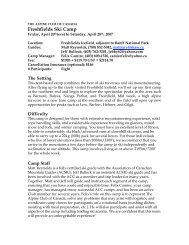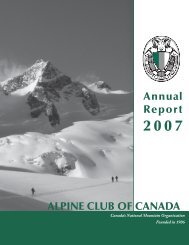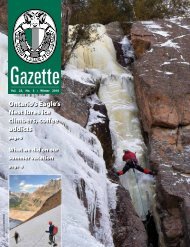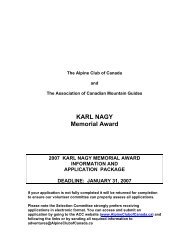A Passion for the Mountains - The Alpine Club of Canada
A Passion for the Mountains - The Alpine Club of Canada
A Passion for the Mountains - The Alpine Club of Canada
Create successful ePaper yourself
Turn your PDF publications into a flip-book with our unique Google optimized e-Paper software.
Las Mujeres de Las Montanas 2002<br />
Celebrating women’s passion <strong>for</strong> mountains in Ecuador<br />
by Isabelle Daigneault<br />
As<br />
close friends, Olivia and I sought<br />
a new challenge to honor <strong>the</strong><br />
2002 International Year <strong>of</strong> <strong>Mountains</strong>.<br />
We created <strong>the</strong> Ecuador 2002 project to<br />
introduce local and indigenous Ecuadorian<br />
mountain women to high-altitude trekking<br />
and mountaineering in ef<strong>for</strong>t to inspire<br />
<strong>the</strong>m to fur<strong>the</strong>r develop character and<br />
community leadership skills. Our goal<br />
was not to impose, not to patronize, but<br />
simply to inspire o<strong>the</strong>r women, to share<br />
our passion <strong>for</strong> mountains and to produce a<br />
short documentary on this subject.<br />
Why Ecuador?<br />
Ecuador is a country rich in diverse<br />
peoples and landscapes. Never have I<br />
felt mountains to be so alive, landing<br />
at <strong>the</strong> airport only days after volcano El<br />
Reventador exploded, covering Quito with<br />
fi ve centimetres <strong>of</strong> ash. Frequent eruptions<br />
<strong>of</strong> Ecuador’s numerous volcanoes remind us<br />
its mountains are very much alive. Home to<br />
<strong>the</strong> world’s highest active volcano, 5911 m<br />
Cotopaxi, and <strong>the</strong> world’s highest mountain<br />
from <strong>the</strong> center <strong>of</strong> <strong>the</strong> earth, 6097 m<br />
Chimborazo, Ecuador provides beautiful<br />
scenery and fantastic mountaineering<br />
opportunities.<br />
Due to economic and social limitations,<br />
most Ecuadorian women do not have <strong>the</strong><br />
opportunity to enjoy <strong>the</strong> outdoors, nor<br />
do <strong>the</strong>y strive toward mountaineering, a<br />
traditionally male-dominated activity. On<br />
a desolate country trail you’ll <strong>of</strong>ten see<br />
a myriad <strong>of</strong> people in red, pink or blue<br />
carrying piles <strong>of</strong> wood or working <strong>the</strong> land<br />
– <strong>the</strong>y are all women. Women care <strong>for</strong><br />
<strong>the</strong>ir families and work all week long with<br />
land and animals, while <strong>the</strong> men work in<br />
cities. Being submissive to <strong>the</strong> expectations<br />
Interviewing Olga & Aurora at <strong>the</strong> Collanes Plains Hut, El Altar Volcano<br />
18 <strong>Alpine</strong> <strong>Club</strong> <strong>of</strong> <strong>Canada</strong> ● Gazette ● Summer 2003<br />
<strong>of</strong> a culture, however, does not mean that<br />
one cannot or does not have leadership<br />
and cannot empower oneself to start new<br />
projects, teach o<strong>the</strong>rs or attempt to improve<br />
life.<br />
<strong>The</strong> Women<br />
As <strong>the</strong> co-owner <strong>of</strong> Quito-based Safari<br />
Tours, Pattie is one <strong>of</strong> only a handful <strong>of</strong><br />
Ecuadorian female mountaineers. She<br />
recently started mountaineering to better<br />
understand what draws her clients to<br />
Ecuador’s mountains. Pattie told us she<br />
was received with a lot <strong>of</strong> awe and surprise<br />
when she returned to <strong>the</strong> hut after climbing<br />
Approaching <strong>the</strong> refuge at Cotopaxi<br />
her fi rst peak, Iliniza South. We wanted to<br />
climb Cotopaxi with Pattie because she had<br />
attempted it twice without reaching <strong>the</strong><br />
summit and thought it could be a milestone<br />
in her life and Ecuadorian mountaineering.<br />
Olga, 21 and Aurora, 18 are<br />
part <strong>of</strong> an organization called<br />
‘La Minga’, <strong>the</strong> association<br />
<strong>of</strong> indigenous women <strong>of</strong> <strong>the</strong><br />
province <strong>of</strong> Chimborazo, home to<br />
Chimborazo volcano. <strong>The</strong>y work<br />
<strong>the</strong> land daily, caring <strong>for</strong> animals<br />
and as part <strong>of</strong> <strong>the</strong>ir duty to La<br />
Minga, visit several elementary<br />
schools in <strong>the</strong>ir region <strong>of</strong> Colta<br />
to help feed and educate children.<br />
Following Ecuadorian tradition,<br />
<strong>the</strong>y are bound to live and work<br />
with <strong>the</strong>ir parents until <strong>the</strong>y are<br />
Olivia S<strong>of</strong>er & Isabelle Daigneault - Cotopaxi, Ecuador<br />
married. We built relationships with <strong>the</strong>m<br />
via <strong>the</strong> Internet over several months. For<br />
<strong>the</strong>ir fi rst experience, we planned to take<br />
<strong>the</strong> two young women on a three day<br />
expedition to Volcano El Altar, where <strong>the</strong>y<br />
would gain serious altitude, approach a<br />
glacier and see a mountain peak up close<br />
– and evaluate whe<strong>the</strong>r or not <strong>the</strong>y enjoyed<br />
mountain climbing.<br />
<strong>The</strong> Climbs<br />
Acclimatization <strong>for</strong> Cotopaxi and<br />
5404 m El Altar was key. Olivia, our<br />
cinematographer Doug and I acclimatized<br />
on 4200 m Pasochoa and 4784 m GuaGua<br />
Pichincha, which erupted in 1999 and<br />
5116 m Iliniza Norte with Pattie. <strong>The</strong><br />
Illiniza Norte climb was not technically<br />
diffi cult. Formerly covered in snow,<br />
footing on <strong>the</strong> peak has been made easier<br />
with exposed rock caused by recent global<br />
warming. Bordered by jungle, <strong>the</strong> climb was<br />
wonderful and Pattie was happy to summit<br />
her second ever peak.<br />
After leaving <strong>the</strong> 4800 m Cotopaxi<br />
refuge at midnight on three hours sleep,<br />
our team climbed with headlamps.<br />
Un<strong>for</strong>tunately, Pattie felt weak a few hours<br />
later, just short <strong>of</strong> <strong>the</strong> glacier. She turned<br />
back and we continued.<br />
<strong>The</strong> day rose as we approached <strong>the</strong><br />
summit where we crossed lots <strong>of</strong> crevasses.<br />
Approaching 5400 m, we felt dizzy. <strong>The</strong><br />
effects <strong>of</strong> altitude are very strange – climbing<br />
and taking steps <strong>for</strong>ward – it does not feel<br />
like it’s really you. Your mind becomes your<br />
most powerful ally.<br />
Accompanied by high winds and high<br />
altitude hail, I felt tired. My body wanted<br />
to give up. My mind wanted to climb<br />
and ‘bag’ this peak and see <strong>the</strong> crater. At<br />
Yanasacha Pass, approximately 200 m below<br />
<strong>the</strong> summit, inside a hidden ice haven we<br />
ate, rested and debated as to whe<strong>the</strong>r or<br />
not to make <strong>the</strong> summit. We tried leaving<br />
Yanasacha Pass but in <strong>the</strong> wind again



